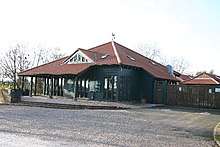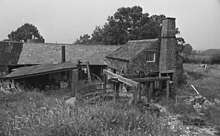Wetheriggs Pottery
Wetheriggs Pottery is a pottery on the C3047 road, east of the hamlet of Clifton Dykes, in the civil parish of Clifton, Cumbria 5 miles (8.0 km) southeast of Penrith. It opened in the mid 19th century providing farm and housewares for local consumption, later the business diversified into craft pottery, and, towards the end of the 20th century became focused as a visitor attraction, and in nature conservation work.

The pottery centre closed down in 2008 and the site then relaunched as an animal rescue centre, open to the public. Up until 2014 when the centre relocated to Barnard Castle in County Durham it was known as the known as Wetheriggs Zoo and Animal Sanctuary.
History
The pottery developed on a site belonging to the Brougham estate. Its beginnings can be traced to 1855 when local clay from Clifton Dykes was used for the production of bricks, tiles and pipes. Production of pottery began in 1860 when John Schofield and Margaret Thorburn moved to the site from Stepney Bank Pottery in Newcastle. John Schofield died in 1917, and Margaret Thorburn in 1937. The pottery remained in the Schofield and Thorburn family's hands until 1973. It was given Ancient Monument status in 1973.

The enterprise was provided with fuel (coal) via a siding from the Eden Valley railway line, when the railway closed in 1962 the pottery kiln fell out of use. The beehive kiln remains, as does a blunger for preparing suitable clay. The steam engine used to drive the pottery machinery was restored in the 1990s by Fred Dibnah. Facilities built for visitors including a museum.
Pottery making was revived at Wetheriggs, as the only remaining steam-powered pottery in the country. Mary Chappelhow became the master potter at Wetheriggs in 2003:[1] production has since ceased at the site, but she works at Brougham Hall.
In 2006 an animal rescue and conservation centre opened Wetheriggs Animal Rescue & Conservation Centre, with the ultimate aim of recreating the now extinct Cumberland Pig. The Rescue Centre has since moved to County Durham and the Pottery site is now privately owned.
See also
References
- Profile www.interludeceramics.com
Further reading
- Wetheriggs Country Pottery detailed description of the working pottery, via www.cumbria-industries.org.uk
- Wetheriggs Pottery: A History and Collectors Guide, Barbara Blenkinship, Spencer Publications, 1998